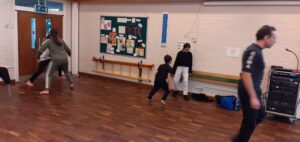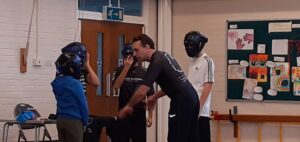Children's Self-Protection for Forest School of Karate (diary entry)
- jamie03066
- Mar 8, 2022
- 3 min read

05.03.2022
My weekend seminar for Forest School of Karate began with a two-hour "When Parents Aren't Around" lesson. This was delivered as a hard skills lesson, the school already having covered the soft skills via Zoom. We used the following activities:
Tactical Escape Agility Training - Serving as a warm-up, we used agility cones to encourage serpentine running and lateral running whilst avoiding objects.
Purpose: Besides general agility and fast-twitch conditioning being essential requirements for tactical escape training, participants are taught to have better awareness of hazards.

- Pairing off, one student tries to block whilst the other tries get around them without touching.
Purpose: This is a great exercise for encouraging smaller people to avoid larger assailents. They learn how to quickly turn and to use footwork specific for tactical escapes within restricted areas. By making this a no-contact exercise, both students can focus on the specifics of non-combative self-defence tactics.
Build-up Tig (Tag or It)/Bulldogs - One student is defined as the single enemy who must recruit people by tagging them with their hand.
Purpose: This popular children's game of catch serves as a great introduction to understanding basic patterns of predatory behviour. Students get understand likely targets and how to best use agility to avoid being caught.


- This game involves a small group of participants (usually larger ones) donning head guards and milling around the rest of the class prior to launching their attacks. The head guards designate predators, symbolising the psychological pre-incident indicators as well as providing a protected target for the prey (the rest of the class). On the sidelines adult martial arts instructors stood by to play the role of bystanders. Predators are restricted to clinching techniques. They have to hold onto their prey for five seconds. The prey have to break free or fend them off within this timeframe. Prey can call for help to the bystanders, but they must lock eyes with the bystander and issue a direct command.
Purpose: The two minutes of non-aggressive action demonstrates how quickly potential dangers can become accepted and then ignored within a community. Making the attack time so short shows the speed of how quickly a predator can take action and subdue their prey. Keeping the predators as grapplers/clinchers and the prey as strikers/anti-grapplers an asymmetrical fighting dynamic is maintained rather than what would normally seen in consensual violence. The exercise also brings forward discussions on how victims are selected, what tactics work, what tactics don't work and how to recruit help. Both predators and prey learn by at least the second time at this exercise to cooperate with their allies.

- All of the above was then used to inspire setting boundary lines and build fences for targets that are usually smaller or have a severe range disadvantage to potential threats. This is the normal problem faced by children. I taught striking against whatever occupied the target's personal space prior to exiting off that line of attack. We also added in additional strikes to available targets should they be presented and the exit was not immediately present. Purpose: This is direct training, emphasising counter-assault methods used to fight to flee. Throughout the two hours we discussed the 10/80/10 rule, the Bystander Effect, fear, situational awareness including knowing where exits were and where they led to in any given environment and what constitutes an immediate threat - accessibility, capability and intent (the threat triangle). Here are links to more notes taken from my full children's self-protection seminar in Denmark. Day 1Day 2 The book to accompany this course is available on Amazon and SmashWords Amazon PageSmashword Page https://clubbchimera.com/courses/













Comments